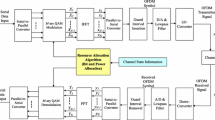Abstract
Orthogonal frequency division multiplexing (OFDM) is proved to be the best candidate to support the colossal increase in mobile users and their required high rate of transmission in frequency selective fading environments, where the inter-symbol interference is at highest. In an OFDM system, when the sinusoidal signals of the subcarriers are added constructively, the peak to average power ratio (PAPR) becomes very large causing major drawbacks for multicarrier signaling. Earlier efforts to address this problem have been mainly concentrated on the reduction of signal PAPR and various methods of achieving linear and efficient power amplification. However, all the deployed techniques suffer from different ambiguities such as high distortion, complexity, computational time, memory requirements, and above all, the data rate loss. This manuscript is mainly aimed at solving a convex optimization problem in which power and radio resources in an OFDM system are allocated among different subcarriers and users in order to, maximize the weighted sum rate for different users considering total power and PAPR limitations.







Similar content being viewed by others
References
Nader, C., Handel, P., & Bjorsell, N. (2011). Peak-to-average power reduction of OFDM signals by convex optimization: Experimental validation and performance optimization. IEEE Transactions on Instrumentation and Measurements, 60(2), 473–479.
Wong, C. Y., Cheng, R. S., Letaief, K. B., & Murch, R. D. (1999). Multiuser OFDM with adaptive subcarrier, bit, and power allocation. IEEE Journal on Selected Areas in Communications, 17(10), 1747–1758.
Kim, S. S., Kim, M. J.,& Gulliver, T. A. (2006). A new PTS for PAPR reduction by local search in GA. In International joint conference on neural networks Sheraton Vancouver Wall Centre Hotel, Vancouver, BC, Canada (pp. 16–21).
Sohn, I. (2016). New SLM scheme to reduce the PAPR of OFDM signals using a genetic algorithm. ICT Express, 2(2), 63–66.
Singh, R. K., & Fidele, M. (2015). An efficient PAPR reduction scheme for OFDM system using peak windowing and clipping. In Third international conference on image information processing.
Harne, S., & Zanjade, A. (2016). PAPR reduction in OFDM system using phase sequence of Riemann matrix. International Advanced Research Journal in Science, Engineering and Technology, 3(9), 56–60.
Hosseini, E., & Falahati, A. (2013). Improving water-filling algorithm to power control cognitive radio system based upon traffic parameters and QoS. Wireless Personal Communication, 70(4), 1747–1759.
Jeng, S. S., Chen, J. M., & Chang, P. H. (2011). A low-complexity companding technique using Pade approximation for PAPR reduction of an OFDM system. International Journal of Communication Systems (IJCS), 24(11), 1467–1479.
Mohammady, S., Sidek, R. M., Varahram, P., Hamidon, M. N., & Sulaiman, N. (2013). A low complexity selected mapping scheme for peak to average power ratio reduction with digital predistortion in OFDM systems. International Journal of Communication Systems (IJCS), 26(4), 481–494.
Hasan, M. M., & Singh, S. S. (2012). An overview of PAPR reduction techniques in OFDM systems. International Journal of Computer Applications (IJCA), 60, 33–37.
Wunder, G., Fischer, R. F. H., Boche, H., Litsyn, S., & Jong, S. N. (2013). The PAPR problem in OFDM transmission: New directions for a long lasting problem. IEEE Signal Processing Magazine, 30(6), 130–144.
Jiang, T., & Wu, Y. (2008). An overview: Peak-to-average power ratio reduction techniques for OFDM signals. IEEE Transactions on Broadcasting, 54(2), 257–268.
Jiang, W., Xing, B., Wang, J., Ni, Y., Peng, C., Zhu, X., & Hong, W. (2007). Performance improvement of power amplifiers with digital linearization technology. In Proceedings of Asia-Pacific microwave conference (pp. 11–14).
Sen, S., Senguttuvan, R., & Chatterjee, A. (2008). Concurrent PAR and power amplifier adaptation for power efficient operation of WiMAX OFDM transmitters. In Proceedings of IEEE, radio and wireless symposium (pp. 22–24).
Sezginer, S., & Sari, H. (2007). Metric-based symbol predistortion techniques for peak power reduction in OFDM systems. IEEE Transactions on Wireless Communications, 6(7), 2622–2629.
Cimini, L. J. (1985). Analysis and simulation of a digital mobile channel using orthogonal frequency division multiplexing. IEEE Transactions on Communication, 33(7), 665–675.
Han, S. H., & Lee, J. H. (2004). PAPR reduction of OFDM signals using a reduced complexity PTS technique. IEEE Signal Processing Letter, 11(11), 887–890.
Jiang, T., Guizani, M., Chen, H. H., Xiang, W., & Wu, Y. (2008). Derivation of PAPR distribution for OFDM wireless systems based on extreme value theory. IEEE Transactions on Wireless Communications, 7(4), 1298–1305.
Ochiai, H., & Imai, H. (2001). On the distribution of the peak-to-average power ratio in OFDM signals. IEEE Transaction on Communication, 42(2), 282–289.
Wei, S. Q., Goeckel, D. L., & Kelly, P. E. (2002). A modem extreme value theory approach to calculating the distribution of the peak-to-average power ratio in OFDM Systems. In Proceeding IEEE international conference on communications (Vol. 3, pp. 1686–1690).
Tang, Z., Wei, G., & Zhu, Y. (2009). Weighted sum rate maximization for OFDM-based cognitive radio systems. Telecommunication System, 42(1–2), 77–84.
Boyd, S., & Vandenberghe, L. (2004). Convex optimization. Cambridge: Cambridge University Press.
Author information
Authors and Affiliations
Corresponding author
Additional information
Publisher's Note
Springer Nature remains neutral with regard to jurisdictional claims in published maps and institutional affiliations.
Rights and permissions
About this article
Cite this article
Falahati, A., Anarakifirooz, E. Weighted Sum Rate Maximization Under the Given PAPR Constraints for a Multi-user OFDM System. Wireless Pers Commun 109, 127–137 (2019). https://doi.org/10.1007/s11277-019-06554-0
Published:
Issue Date:
DOI: https://doi.org/10.1007/s11277-019-06554-0




